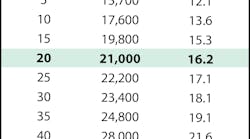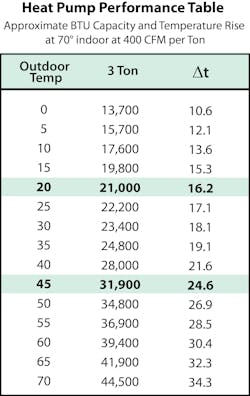The amount of heating or cooling an HVAC system delivers is constantly changing. In the morning, a 3-ton heat pump may deliver 21,000 BTU and have a 16F temperature rise. That afternoon, its capacity may increase to 32,000 BTU with the temperature rise increasing to 24F. Equipment rated cooling capacity also changes hour by hour. Let’s take a look at how you can find and use equipment heating and cooling capacity.
As indoor and outdoor conditions change, the capacity of heating and cooling equipment also changes. As an HVAC professional, an important part of your job is being able to identify what the equipment capacity is at the time you are assessing its performance.
There are a few bits of information you’ll need to get started.
First, identify the manufacturer and model number of the equipment. Then go online to the manufacturer’s website and download the specifications for that piece of equipment. You can do this on your computer, tablet, or phone. You’ll need these specifications to determine equipment capacity.
Second, measure the indoor and outdoor temperature. All manufacturers’ specifications provide an indoor and outdoor temperature that the equipment was tested under when it was rated in the laboratory. When you measure indoor and outdoor temperatures, you’ll know what conditions your equipment is operating under and you can find the corresponding rated capacity in the manufacturers’ specifications.
Third, determine the fan airflow. This can be done in a couple of minutes by measuring the air handling equipment’s total external static pressure and verifying the fan speed setting. Using these two pieces of information, you can plot the fan airflow on the manufacturer’s fan performance tables.
Fourth, find the equipment’s capacity under current operating conditions by plotting the fan airflow and operating temperatures on the manufacturer’s heating or cooling capacity tables.
Servicing Equipment
When servicing a system, often temperature change over the equipment is measured. Keep in mind that variations in outdoor temperature and fan airflow will significantly change the capacity of HVAC equipment and how you troubleshoot system performance.
How many times have you misdiagnosed a system because you didn’t check the specifications and you relied on rules of thumb? Don’t worry, you’re not alone.
Interpreting System Performance
When testing and calculating HVAC system performance, you’re already measuring the outdoor and indoor temperatures and plotting fan airflow. So you have already done the hard part. The last step in assessing system-operating efficiency requires you to divide the system delivered BTU into the equipment rated BTU. If you fail to verify the equipment manufacturer’s rated capacity and assume 12,000 BTU per ton, your operating efficiency rating will be incorrect and all that work will go down the drain.
Take another minute to check the specifications and finish the job right. In cooling mode, it could be 12,000 BTU per ton at 85F outdoors. It could be 14,000 BTU per ton at 65F outdoors. Or it could be 10,000 per ton at 115F outdoors.
When measuring system performance, the last step is to check your specifications.
Sizing Equipment
So, you completed a Manual J load calculation and the heat gain of the house is 36,000 BTUs. That’s a 3-ton air conditioning system, right? Well, maybe and maybe not.
Manual J is incomplete without using Manual S to choose the right equipment. Manual S refers you to the manufacturer’s equipment specifications. Equipment capacity is variable; it increases and decreases. The single AHRI equipment rated BTU listed on their website is just a starting point. Unless you adjust equipment capacity to match the outdoor and indoor design conditions (and fan airflow) you will most likely fail to choose the right equipment for the job.
If you’re in a cool area of the country under summer design conditions, equipment capacity will be greater. In a warmer area of the country, the equipment capacity will be significantly less.
So you have never used Manual S, or adjusted equipment capacity to match design conditions? I remember the day I learned this critical step. I thought I was gonna die. But I didn’t and learned to do better. That’s life, isn’t it?
Where to get Equipment Specifications
Equipment specifications are all available online. If you need help finding them, contact your local distributor.
By now it should be pretty clear that you need to refer to manufacturer specifications when servicing, testing, designing or selling HVAC systems. Equipment capacity does change depending on temperature and airflow.
It is part of your job to check the specifications and take that last step to do your best.











